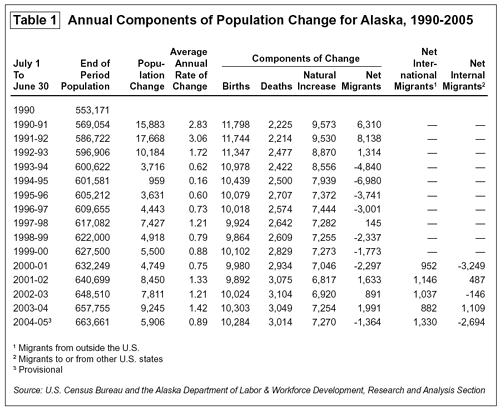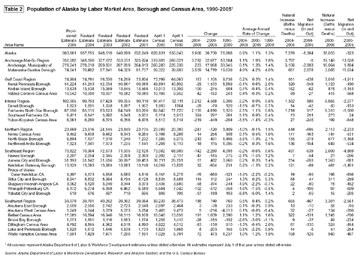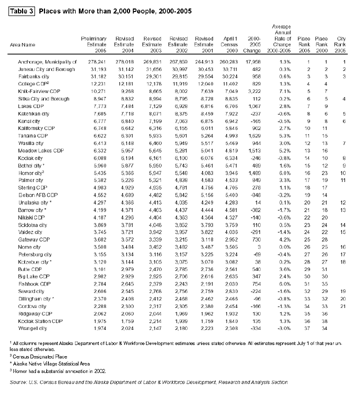 February 15, 2006
Alaska's growth was slightly faster than the 5.0 percent growth in the same period for the U.S. as a whole. The number of people living in the state climbed from 626,931 at the time of the April 2000 Census to a provisional July 1, 2005, estimate of 663,661. (See Table 1.) 
From April 1, 2000, to July 1, 2005, Alaska's natural increase (births minus deaths) added 37,053 people (See Table 2 - Population of Alaska by Labor Market Area, Borough and Census Area, 1990-2005), while net migration (in-migration minus out-migration) accounted for a loss of 323 people. During the 2004-2005 period, Alaska added 7,270 people through natural increase and lost 1,364 people to out-migration. This reverses the in-migration trend that occurred in the 2001 to 2004 period. In the early 1990s, Alaska added about 9,600 people each year through natural increase. The current slowdown in natural increase is a product of fewer births and greater deaths as Alaska's baby boomers age.
When international and domestic migration are considered, the loss of 1,364 migrants between 2004 and 2005 breaks down into a gain of 1,330 international migrants and a loss of 2,694 domestic migrants. Interna tional migration is currently compensating for some of the outward domestic migration. It is important to note that because he Alaska Department of Labor & Workforce Development's estimates are for resident population, any troops deployed overseas are counted as being in Alaska in their estimates. This means that the populations for the Fairbanks North Star Borough and the Municipality of Anchorage, where the main Alaska bases are located, will be lower than these estimates indicate. Department of Labor population estimates have also been released for Alaska's 27 boroughs and census areas, as well as for 349 occupied places located throughout the state. Most of Alaska's boroughs and census areas have grown slowly or lost population in the 2000-2005 period. The largest population increases have occurred in the Municipality of Anchorage (+17,958), Matanuska-Susitna Borough (+14,719), Fairbanks North Star Borough (+4,810), Kenai Peninsula Borough (+1,533), Bethel Census Area (+1,039), Juneau City Borough (+482) and the Wade Hampton Census Area (+473). Of the 27 boroughs and census areas, only 11 gained population in the 2000-2005 period. Population growth in the Municipality of Anchorage and the Mat-Su Borough accounted for roughly 89 percent of the state's overall growth. The Municipality of Anchorage made up 43 percent of the growth in the 11 areas with population gains and the Mat-Su Borough made up 35.2 percent. The Mat-Su Borough remains the fastest growing area of the state, as it has been since 1990. In the 2000-2005 period, it grew at an average annual rate of 4.2 percent, which is comparable to its 4.0 percent annual growth rate during the 1990s. The increases in both the Municipality of Anchorage and the Mat-Su Borough in the 2000-2005 period were due to a mix of natural increase and migration. Anchorage had the largest flows of in- and out-migration from other parts of Alaska and from the rest of the U.S., leaving it with a net in-migration of 1,894 people. The Mat-Su Borough was the only area of the state where growth came primarily from net in-migration. Since the 2000 Census, in-migration accounted for 11,634 of the Mat-Su Borough's population increase of 14,719. About half came from in-state with the majority coming from the Municipality of Anchorage. These two areas, plus the Southeast Fairbanks Census Area (+24), were the only instances where in-migration exceeded out-migration over the 2000-2005 period. In the more recent 2004-2005 period, Anchorage gained only 223 people, while the Mat-Su Borough gained 3,559 people, continuing the suburban movement. While Anchorage had a natural increase of 3,106 compared to the Mat-Su Borough's 681 in that period, Mat-Su gained 2,878 migrants while Anchorage lost 2,883. All of the other boroughs and census areas lost population to out-migration or remained unchanged between 2000 and 2005. The Southeast region continued to have the largest overall decline, with a natural increase of 2,609 people and a net out-migration of 4,869 people. Only Juneau and Sitka showed growth between 2000 and 2005. In the 2004-2005 period, three areas had slight gains, primarily through natural increase: Sitka (+115), Juneau (+51) and the Ketchikan Gateway Borough (+32). Between 2000 and 2005, migration out of Southwestern Alaska (-2,561) was less than the natural increase in this region (+3,301). In the Northern region, the natural increase (+2,113) failed to keep up with out-migration (2,233). In the Gulf Coast region, the natural increase (+3,016) kept ahead of out-migration (-1,911). The Kodiak Island Borough had more net out-migration (-1,153) than natural increase (+878) and the Valdez-Cordova Census Area population declined slightly as natural increase (+415) failed to match net out-migration (-568). The Kenai Peninsula Borough grew mainly through natural increase (+1,723) as opposed to net migration (-190). During the more recent 2004-2005 period, Valdez-Cordova and Kodiak Island grew slightly as natural increase exceeded out-migration. In the Kenai Peninsula Borough, however, out-migration (-349) exceeded natural increase (+320) for a slight population decline. In the Interior, the Fairbanks North Star Borough (+4,810) and the Southeast Fairbanks Census Area (+297) grew in the 2000-2005 period, largely due to natural increase. The Yukon-Koyukuk Census Area (-449) and Denali Borough (-70) shrank as out-migration exceeded natural increase. During the 2004-2005 period, the Fairbanks North Star Borough (+2,135) and Southeast Fairbanks Census Area (+324) both gained as a result of natural increase and in-migration. Alaska had 35 places with populations over 2,000 in 2005 (See Table 3 - Places With More Than 2,000 People); 21 of them are incorporated cities or cityboroughs. Thirty-two places in Alaska have populations of more than 2,500, the old U.S. Census Bureau definition of urban place. The Municipality of Anchorage continues to dominate the state. Its population of 278,241 in 2005 accounts for 41.9 percent of the state's population, up slightly from 41.5 percent in 2000; the Anchorage/Mat-Su region (352,282) accounts for 53.1 percent of the population. The places with populations greater than 2,000 that have had the highest average annual growth rates since the 2000 Census include the Knik-Fairview Census Designated Place (+7.1%), Homer city (+6.0 percent), Fishhook CDP (+6.0 percent), Tanaina CDP (+5.3 percent), Meadow Lakes CDP (5.2 percent), Gateway CDP (4.2 percent) and Butte CDP (3.6 percent). All but two of the top 12 places that experienced the most rapid growth in the 2000-2005 period are in the Mat-Su Borough. Indeed, if they were to incorporate, four places in the Mat-Su Borough would be larger than the cities of Wasilla and Palmer, and Knik-Fairview would become the fourth-largest city in the state. The remaining two rapidly growing places are the Kalifornsky CDP and Homer city in the Kenai Peninsula Borough. Homer's growth, however, is largely due to its annexation of a substantial part of Diamond Ridge and Miller Landing. A dozen of the 35 places that had more than 2,000 people in 2000 have declined. The areas that declined on average by more than 1 percent each year during the 2000-2005 period are Eielson Air Force Base CDP (-3.2 percent), Wrangell city (-3.0 percent), Barrow city (-1.7 percent), Seward city (-1.6 percent), Valdez city (-1.4 percent) and Cordova city (-1.3 percent).
Source of News & Tables:
Publish A Letter on SitNews Read Letters/Opinions
|
||

